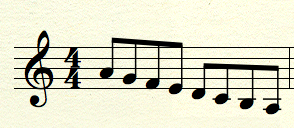Forms of the Minor Scale
Ever major scale has a relative minor scale. The root of the relative minor scale is a minor third lower than the major. Another way to look at it is that the root of the minor scale is the sixth scale degree of the major scale. For C major, that means the relative minor’s root is A.
The Natural Minor scale contains all the same pitches as its relative major. That is, we just change the root so an A instead of C. Here’s the major scale followed by its relative minor.
However, this scale lacks a really strong pull towards tonic due to the lack of a leading tone. The leading tone is the 7th note of a major scale, and also the third of a dominant chord. In order to get the leading tone into the minor scale and create a major dominant chord in a minor key, we simply raise the seventh scale degree of a natural minor scale by one half-step. This creates a new scale form called the Harmonic Minor.
The final scale form is Melodic Minor in which the sixth and seventh scale degrees are raised by one half-step. This creates a stronger pull towards tonic and also eliminates the very colorful F to G# melodic line that can be created using only the harmonic minor scale. Technically speaking the melodic minor has an ascending form in which the sixth and seventh notes are raised and a descending form where they return to their original notes. The descending melodic minor scale is the same as the natural minor.
Modal Borrowing
Another way to look at minor scale is that they are “borrowing” notes from other key areas. If you play the melodic minor scale, it sounds very close to a major scale. By starting on a different pitch, we reorganized the series of whole and half steps within a scale, giving it a different sound.
But composers like to borrow notes from other key areas to add color and interesting harmonies. In the case of the minor scale, the borrowed notes are more for practical purposes: to make the dominant a major chord where it otherwise wouldn’t be and increase the key area’s pull towards tonic.
In a sense the harmonic and melodic minor scales are borrowing the leading tone and raised sixth scale degrees from the parallel major key. The parallel major key is the major key with the same tonic as our minor. In this case, are parallel major is A major, which contains the notes: A B C# D E F# G#. The harmonic minor borrows the leading tone, G#, while the melodic minor borrows both F# and G#.





